#Great Northern Railway
Explore tagged Tumblr posts
Text
London's St Pancras station epitomises High Victorian architecture.


Thousands of goodbyes took place on St Pancras' platforms in WWII
#St Pancras#London#British Rail#railway station#farewells#'Goodbye' statue#transportation hub#Victorian architecture#Great Northern Railway#WWII#partings#UK#British history
75 notes
·
View notes
Text



For my next electric locomotive build in Minecraft, here is the mighty Great Northern W-1. The chassis was used from CraftyFoxe's Union Pacific Coal Turbine build since No. 5018 was reused for the coal turbine of course (credit to CraftyFoxe BTW). As for building the rest of the locomotive, the only challenging part for me was to build the slanted streamlined noses on the two ends of the locomotive. But other than that, it was an easy build. Happy Thanksgiving!
UP Coal Turbine tutorial: https://www.youtube.com/watch?v=SN9GDd4H0AM
NOT AN OFFICIAL MINECRAFT BUILD. NOT APPROVED BY OR ASSOCIATED WITH MOJANG OR MICROSOFT
#Minecraft#Minecraft Build#Minecraft Build Showcase#GN#Great Northern#Great Northern Railway#Great Northern Railroad#W-1#GN W-1#Great Northern W-1#Electric Locomotive#Trains
24 notes
·
View notes
Text
The Brothers & Sisters Breakdown
Chapter four (intro)
The Two Pacifics in 1922
It has been two years and a couple of months since… ‘Gordon’ was built.
~~
‘The Prototype eng- … no, ‘Gordon’ was on a host in the back end of the workshop. There ‘he’ hung and stayed resting on a host at the rear.
Despite being placed on the ground rails after a long while of being up there, the situation did not improve, as the environment remained uninviting and neglected. He was kept in the very back of the workshop, it was dark, cold and wet at the back. Languished in the shadows of the workshop. Darkness and dampness contributed to a sense of abandonment. The conditions in which Gordon was kept contributed significantly to a feeling of neglect and abandonment. The shadows of the workshop enveloped him, and the persistent dampness only exacerbated the sense of being forgotten. Surrounded by an array of tools and machinery, Gordon seemed to fade into the background, overshadowed by the clutter that filled the space. Labelled as the pathetic prototype, faulty prototype, or failed prototype… Gordon has long since resigned himself to his fate, embodying a sense of acceptance despite the circumstances that have led to his current state.
#the brothers and sisters breakdown au#please take a chance to read#ttte fanfic#my writing#my art#ttte gordon#ttte greendon#gordon the big engine#gordon the express engine#ttte#ttte great northern#ttte sir frederick banbury#sir nigel gresley#great northern railway
9 notes
·
View notes
Text
What is the 'Engine Rulebook' and where did it come from?:
So, this really early era of railways was a bit insane, and I am not quite well-versed enough to make a case-study out of everything - but like with my Big 4 scrap post, this is more about trends than singular examples - though some do appear.
The 'Engine Rulebook' is basically the set of rules that every engine ever is taught when built. It's a series of important rules, customs and doctrine used by managers to keep engines in line. Yes, I will use a little business-management theory in here, because early management styles have a major effect. And every railway has its own rulebook that may have differences. But there are a few key things in the 'Engine Rulebook' that I see being universal:
1: The company comes first. This is basically the company ensuring loyalty by indoctrinating the engine to see its railway company as the most important aspect of their life. In the Railway Series, Donald and Douglas have very strong ties back to Scotland and the Caledonian railway - which is why they enjoy blue so much. It's the Caledonian Railway colour! And then there's Duck - who literally continues to wear his GWR colours even after joining the NWR. He's deeply connected to the GWR because of this loyalty taught to him.

2: Railway rules. This includes signalling, signage, speed limits, whistles and their uses, headcodes, flags and every other piece of railway rules. They are read the rulebook, and learn everything in it. It's vital! Percy is an industrial engine who is never taught this rulebook - because industries don't have many engines and often pilfer bits from a bigger company's - and thus Percy doesn't know much about the rules of being on a railway when he arrives on Sodor.

3: Etiquette (based on duty). Now, I don't mean bowing or curtseying or the proper fork for fish - I mean the ins and outs of the duty the engine will be expected to complete. Passenger engines learn how to handle coaches and speak politely to passengers, freight engines learn how to handle trucks and look after different cargos, shunting engines learn a new set of rules for the yards - this sort of thing. Gordon struggles with trucks because he was never taught how to handle them.

4: The managers are always right. Touched on this in a reblog of this @mean-scarlet-deceiver ramble, but its basically that the engines are taught that their managers are right in all contexts (unless breaking one of the above rules) and need to be respected and have all directions followed. The manager says to shunt - you go and shunt. They say to go get scrapped - and a good engine listens without hesitation. Doesn't work out in real life all the time - see Oliver, or the Big Engines' strike - but it definitely keeps most engines in line.
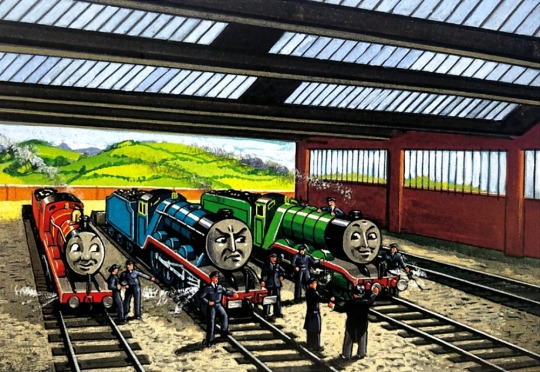
So we have these four core rules - but where did they come from? Well...
Regency Era Railways:
Straight off the bat - this is the era where every railway is figuring itself out. The L&MR was where everything was forged in fire - before it, the only railways that existed were isolated plateways in mines and the Stockton & Darlington Railway. None of these were anywhere near as complex as the L&MR, which is really the first railway 'system' in the way we might understand today. It's also where the first sentient engines begin to make a proper appearance and have an effect on people. Before, they were hidden in mines, if they existed at all - but now the public can see them!

Like, imagine this rocks up to collect you in an era when the most advanced method of transport is literally a horse. And it has a face. Remember, in this period people though that if they went over a certain speed or through a tunnel they would explode - so now the thing that might just kill them has a face?!
Managers would very quickly begin implementing ways to soothe their passengers. One way of doing that would be to dehumanise the engines - I can see many early engines being given basically no education because they are both seen as being 'working class' and because they are machines. When Rocket first ran, there were no public schools.
In this era, engines didn't know much, and they were isolated on their little systems. Yard managers are one of the few people with authority that these engines meet on a regular basis, and they use this to their advantage and cultivate this idea that the engines are entirely subservient to them. This is where that manager loyalty begins to become apparent - just not quite in its modern form.
The only education an engine would get is how to be loyal. Why should they learn signals, or passenger etiquette, or how to read? That is a driver or a guard's job. And so this really early era is characterised by dehumanisation and a lot of public-relations officers doing their best to downgrade the sentience of the engines. It's a lot of "yes they have a face, no they don't have intelligence, don't worry". This does extend into the Victorian era, as seen in Very Old Engines, as Skarloey arrives on Sodor with some principles taught at the workshop, only to be met with "you don't have rights, do your job." Which he naturally rebels at and then gets covered in a tarp for his troubles.
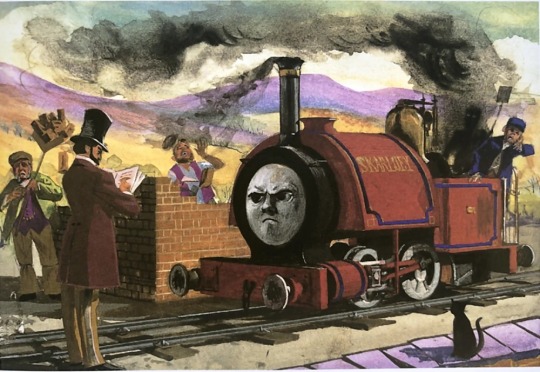
Of course, the Regency Era ends very soon into railway history, and just in time for a major game-changer.
The Victorian Era:
1838 is the year the first GWR train runs, and this railway in the South-west of England will have a huge impact on all railways that come after. First, the entire board of directors are very elitist and influential in parliament. This is a railway that needs to live up to its owners.
It is the GWR, not the L&MR, that writes the first book on engine learning. It's also the GWR, and not any other railway in the UK, that first develops a proper corporate culture for its engines that they actually like. The GWR does this by actually treating the engines like they have sentience.

Engines like Iron Duke are introduced to the 'Great Western Way' - this being the rulebook that Brunel and Gooch develop to best serve their wealthy owners. These engines are taught to read, understand the rules of the railway, passenger etiquette - which by now can be taught because there's less fumbling around blindly - and perhaps most importantly: they are taught a very proud mindset. The railway is the most important aspect of their lives, and they are to serve it to the best of their ability. All four of the rules appear in their first form here, except that the etiquette is not entirely based on duty, and instead all engines are taught all jobs - which horrified much of the rest of the railway companies.
But while this is going on on the GWR, the rest of the country's railways were trying to survive a crisis. Railway Mania swept Britain, and hundreds of engines and built (and destroyed) by the week. One thousand bills for new railways were submitted to parliament during this period, and while not all were built - it certainly had an impact. The LNWR was formed during this period, chunks of the Midland Railway, NER, GNR, GCR, Caledonian and basically every other major railway were all constructed in this time frame - but that didn't mean a drastic improvement in how the engines were treated in this area. Many North-western railways were influenced by the thinking from the L&MR, leading to entire fleets of early engines having zero clue how to act or even speak in some cases. When the bubble collapsed, many engines were scrapped - and this is where the other extremely important pillar stone of railway doctrine was introduced: engines are expendable, and should not want to hinder a company. The fourth rule is set into stone here, and goes unchanged and practically unchallenged all the way into the modern era.

This here, the end of steam in Britain, is able to happen because of principles introduced during Railway Mania. British Railways uses this rulebook and the laws that most likely surround it by this point to justify their actions, and also because thanks to this rulebook very few engines have the vague notion or idea to protest. Why would they, it goes against the rules!
The eradication of steam is almost directly caused by the era of Railway Mania and the principles managers introduced in the era to protect their profit margins. Without that doctrine, engines would have had a lot more rights and a lot more ability to protest being scrapped.
In other words, the 1840's was when scrapping began to appear properly, as well as the explosions, derailments and every other crash from the previous generation. Engines became unfeeling in this era - in the north at least. The GWR escaped this by being... well, not an economic bubble.
However, as the British Isles emerges from Railway Mania, two very strong railways vie for influence: the LNWR and the GWR. The LNWR has that traditional L&MR mindset - and it leads to a huge problem. The engines begin to learn how to speak from their crews, and moreover they question why their GWR counterparts are treated so much better. The LNWR also suffers from a number of easily preventable accidents caused by the engine having zero clue what to do.
Some railways land between the two, and it was the GNR that ended up formulating the four rules in their next evolution: engines were only taught their jobs. This was the GNR compromise with their board members. The board wanted a GWR approach, however the actual managers on the ground rebelled, worrying this would lead to the engines working together to demand fairer treatment. The Communist Manifesto was in major circulation at the time, and none of these companies wanted their engines getting any ideas. Instead, they implemented something of a class system, with express engines at the top and shunters at the bottom.
In the TVS, Emily is extremely abrasive towards Thomas (Seasons 8-12), and it may just have to do with the way she was raised, seeing shunters as the lowest form of engine. Gordon certainly did!

These three very distinct practices all melded and fused together on the Midland Railway - which of course ran right in between them all. The Midland Railway wrote the third proper rulebook in 1859, roughly twenty years after the GWR wrote its.
The Midland Railway's rulebook took the LNWR idea that engines needed to be taught to accept death, the GNR idea of a class system and the GWR importance of company loyalty and railway-rule-knowledge and fused them together, being able to create the rulebook that most British railways would use by 1890. The major exception to this was of course the Great Western, which slowly evolved its rulebook to use the LNWR ideas of engines being subservient to their managers while retaining the classless form of etiquette the engines were taught. The GNR would also hold out on some ideas from the GWR until it was amalgamated into the LNER, due to rising fears of Communism by the board.
Many smaller railways, such as the Furness Railway or the Highland Railway in Scotland, would use the GWR style, due to the smaller size of the workforce, and thus the potential necessity for engines to complete duties they were trained for.

Duck fits into his role at Tidmouth with such ease because he knows the theory behind every express train, every freight train, every style of shunting and branchline service. He doesn't need them, but the GWR engines were taught this just in case. Duck is excellent at his job, but he won't take any flak from the other engines because his GWR ideology makes him see them all as equal. This is of course part of the Great Western Way as explained in this post.
In direct contrast, Gordon has zero clue how to pull a freight train, and stalls on the hill because he physically doesn't know what to do.
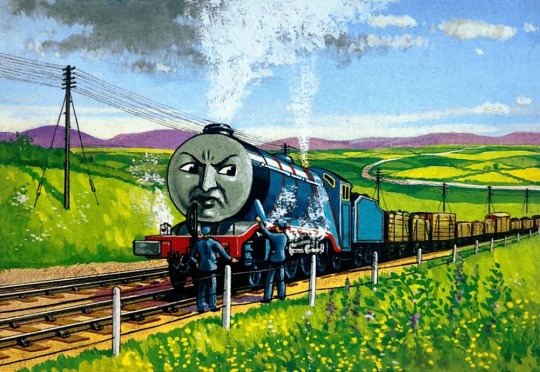
And this brings me quite neatly to Sir Topham Hatt I. See, this is a GWR man who runs a railway that is very heavily influenced by the Midland Railway rulebook ideology. Edward knows how to do multiple tasks because the Furness Railway used GWR practice (maybe that's why he likes Edward?) while none of the other engines do. Sir Topham Hatt's management style using GWR practice is so confusing to them. Why is James - who is mixed-traffic at best - pulling the express? Why is Gordon pulling freight? Why are the big engines shunting?!

And then we have Henry. Sir Topham and Henry have such a rocky relationship, and it in many ways comes from the fact that Henry had none of the formal education that I just discussed. He's a privately-built engine from stolen plans sold cheap. He doesn't actually know the etiquette of a passenger train - no wonder he stops when he doesn't like the weather! He doesn't physically know better, and so he's acting on his first instincts. This clashes so badly with the GWR style which places etiquette almost above everything else. Hatt reacts so badly and outright insanely to this because to him, Henry is actively and deliberately breaking every rule in the book because of his paint? And Henry doesn't have a clue. Look at how horrified he is!
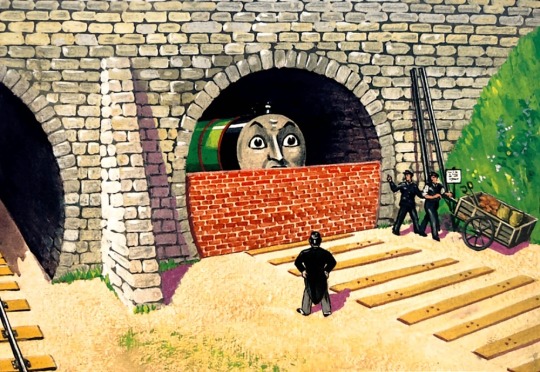
And don't get me wrong, this is extremely unethical and very stupid, but it has a precedence in miscommunication, differing ideologies and Henry's foolishness.
This was another massive ramble with a lot of insanity, but I do enjoy writing these. Helps organise my mind! As usual, none of the above pictures belong to me, and feel free to chuck in a comment with your opinion!
#the 1800s#ttte edward#i need to calm down#thomas the tank engine#railway series#railways#real life railway#what are the rules for trains?#fanfiction writer#ao3 stuff#british rail#british railways#Great Northern Railway#gwr#Midland railway#LNWR#ttte au#sir topham hatt#ttte henry#ttte gordon#ttte skarloey#ttte duck#ttte emily#weirdo shit#long reads#very long post#britain#Great Western way
132 notes
·
View notes
Text

6 notes
·
View notes
Text
Great Northern Railway 131 at Connolly
After dozens of visits to Ireland over a span of 26 years, I finally witnessed former Great Northern Railway 4-4-0 number 131 under steam on 24 March 2024. This also was a reunion with many of my old friends at the Railway Preservation Society of Ireland (RPSI), Irish Rail and Irish Railway Record Society. And, it was Kris’s first trip behind steam in Ireland! Many memorable photos were exposed…
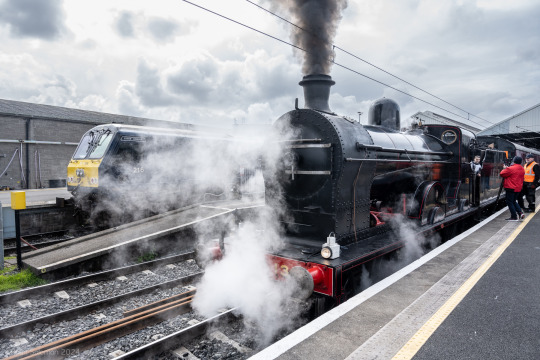
View On WordPress
1 note
·
View note
Text
(TIL: the US had a Great Northern, too)

I have a cold and I'm tired, so I'll post better pictures later, especially ones of the new T-Trak module I recently built. But I did want to show at least this little thing I did with some of the leftover material. Not all of the leftover material, though. I have so much leftover wood strips…
Anyway, this is a very small section of a North American style railroad trestle (I think they're also a thing in Australia?), based on plans by the Great Northern, but then adapted with more bracing because I think that looks better. The height is chosen so that it can be connected to T-Trak modules if you replace the connectors. The track is… I don't actually know. Might be Minitrix? Something I found on my desk.
The wooden structure is all built by hand, out of 2x2 mm balsa wood (main frames), 3x3 mm pine (the sections under the plastic track piece and 1x1 mm linden for the bracings in the longitudinal direction. All cut by hand with a sharp cutter knife (except the 3x3 mm pine, I used a tiny saw for that) and glued together with wood glue.
The locomotive is either Athearn or Atlas, I can never remember which of these is which. I think Atlas. And yes, the rear truck isn't on the rails properly, as I said, I'm sick.
This project was a lot of fun, as was the full T-Trak module (I'll post about that later, hopefully in a couple of days), but also sometimes a bit annoying. I know a couple of places that I could do better, but the main one is the ties. They should be much wider for a bridge like that, but I am not aware of commercially made wide ties. Maybe I'll need 3D printing for that, because I don't think gluing rail profiles to wooden ties is the proper solution. Still, it looks neat as it is. Feel free to ask questions if you have any!
11 notes
·
View notes
Text
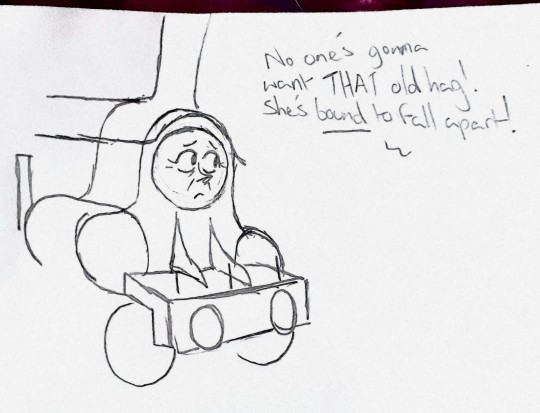
This is a sketch of Emily before she was bought by Sir Topham Hatt.
Warning: Emily headcanon infodump below.
The GNR was a pretty strict railway, and a lot of the engines were mean – especially to Emily, as she was one of the oldest engines there. As a result, she was a punching bag for the younger, more obnoxious engines. It only got worse when they discovered she used to pull high-speed expresses.
Luckily, Emily was taken for an overhaul before things got too ugly, and was bought by Sir Topham Hatt after she was finished. I like to think her bossiness was just a behaviour she had picked up from the GNR, since they practically taught her to be like that as an ex-express engine.
The overhaul made Emily look young and feel young for a number of years before it started wearing off in the BWBA era. She was built on June 21th, 1889. Just six and a half years older than Edward. She's a bit self-conscious of her age, but eventually learned to accept it and is. happy
#thomas and friends#thomas the tank engine#ttte emily#emily the stirling engine#The Great Northern Railway was very strict towards express engines#Poor old girl got bullied#ttte edward#ttte sir topham hatt
71 notes
·
View notes
Text
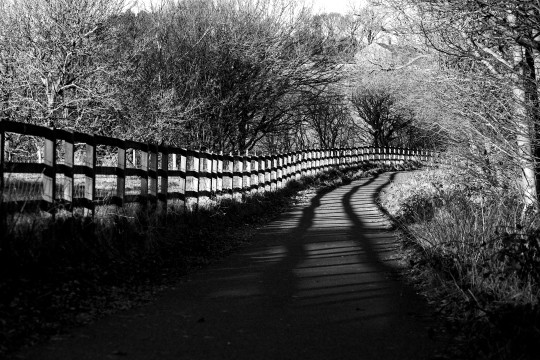
The Great Northern Railway Trail
#great northern railway trail#trail#footpath#sustrans#bradford#yorkshire#landscape#black and white landscape#bnw landscape#landscape photography#black and white#black and white photography#monochrome#bw photography#bw#bnw#bnw photography#photography is my therapy#outdoors#outdoor photography#photographers on tumblr#original work#original content#original photographers#all my own work
57 notes
·
View notes
Text

First drawing of 2025. It's been a while since I drew an electric locomotive, that being the Milwaukee Road Bipolar I drew back in July 2024, so here is the mighty W-1 of the Great Northern Railway.
Refrence Image: https://i.pinimg.com/736x/19/2d/0d/192d0d7da7d3701d73df240e810a019f.jpg
Drawing C) Me
#GN#Great Northern#Great Northern Railway#Great Northern Railroad#W-1#GN W-1#Great Northern W-1#Electric Locomotive#Trains#Train Art#Train Drawing#Train Artwork#Art#Artwork#Drawing#Colored Drawing
3 notes
·
View notes
Text
The Brothers & Sisters Breakdown
It always starts with a prototype… learn how our favourite big blue engine became who he is and his brothers and sisters !
#my writing#my art#my au art#great northern railway#sir nigel gresley#ttte#gordon the big engine#gordon the express engine#ttte gordon#ttte greendon#ttte flying scotsman#ttte fanfic#the brothers and sisters breakdown au
1 note
·
View note
Video
Osage orange by Dean Sauvola Via Flickr: A pair of SD70ACes make for a respectable fake on the rear of a coal empty. The true head end can be seen in the distance towards the top of the hill. East of Osage, WY on the BNSF Black Hills Sub. September 9, 2023.
#BNSF 9231#EMD#Electro-Motive Division#engine#westbound#west#western#northeast Wyoming#Wyoming#WY#Black Hills Sub#mainline#CB&Q#Chicago Burlington & Quincy#Dean Sauvola#BNSF#BNSF Railway#Burlington Northern Santa Fe#coal#Coal Train#unit coal train#sage#sagebrush#pasture#plain#Plains#high plains#great plains#Railway#RR
22 notes
·
View notes
Text
Poster of Great Northern Railway in 1946 USA

Great Northern Railway, 1946
443 notes
·
View notes
Photo

Presenting the Great Western Railway's 57xx pannier tank! Duck has appeared before, but was never quite finished, or given a proper release. Now he is here with 8 of his siblings.
#ttte duck#ttte fanart#rws fanart#island of sodor#North Western Railway#NWR#GWR#Great Western Railway#NCB#National Coal Board#GN&SR#Great Northern and Southern Railway#London Transport#BR#57xx#0-6-0PT#pannier tank#British Railways#*sobs*#The youngest one (BR Lined Black- 6779) was less than nine years old irl#*loads headcanon*#not on my watch#she is preserved in my au#fight me
20 notes
·
View notes
Photo

1946 Great Northern, the New Empire Builder custom-built for pleasant, faster travel
Source: nevsepic.com.ua
Published at: https://propadv.com/railroad-poster-and-ad-collection/great-northern-railway-poster-and-ad-collection/https://propadv.com/railroad-poster-and-ad-collection/great-northern-railway-poster-and-ad-collection/
14 notes
·
View notes
Text
I thought I had left my house in such good shape before I went on a nine-day vacation, and was so proud. Yeah no there was asparagus in the (cold) oven the whole week. #thatADHDlife
At least the oven wasn't on? Go team?
Anyway, it's been fun and I knitted a ton, but dang I missed my cats and am glad to be home.
1) Moses Lake, 2) Dry Falls, 3) Soap Lake, 4) it's called POP here, 5) a cute way of helping people pronounce the town name of Chewelah, 6) from an exhibit on Frank S. Matsura, 7) my BFF since 1991 and me, 8) my mom at a railroad museum, 9) me and my mom and some other tourists on a tiny train ride, 10) my mom at Camlann Medieval Village










#It me#Washington State#Eastern Washington exists too lol#Soap Lake#Dry Falls#Camlann Medieval Village#Northwest Museum of Arts & Culture#Moses Lake#Frank S Matsura#Great Northern & Cascade Railway#Church camp friends are the best friends <3#Chewelah
3 notes
·
View notes